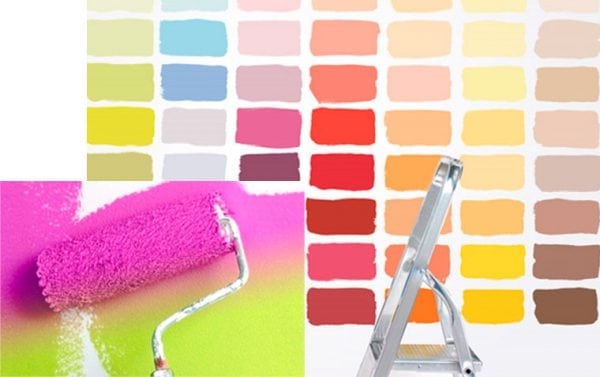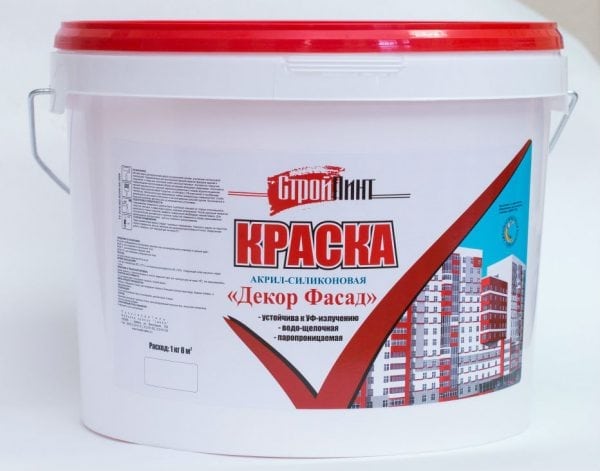One of the most popular types of paints on the construction market is latex and acrylic. True, thanks to marketers, a confusion has developed between these two terms. How different are they really? It is correct to say not “latex or acrylic”, but a little differently - “acrylic-latex”. Because in essence it is one and the same.
- Latex - a natural material
- The advantages of polymer paints
- Varieties of polymer binders
- Polyvinyl acetate
- Styrene butadiene
- Acrylic silicone
- Acrylic Latex
- So which emulsion to choose?

Latex - a natural material
Initially, yes. Latex is a completely natural material that is obtained from the juice of rubber plants. But it happens also synthetic. A synthetic version of latex is an aqueous dispersion of polymer particles with adhesive properties. It turns out that this word in the paint and varnish industry is not called a chemical substance, but a special state of a mixture of substances - the state of water dispersion, that is, particles suspended in water.
Any latex or acrylic paint consists of the following components:
- A binder. This is any polymer or mixture thereof. They are decisive for its properties such as durability, adhesion to the surface (adhesion), resistance and other characteristics.
- Pigment is a powder that is added to give color. This powder does not dissolve. It forms a mixture with a binder, while in suspension in a liquid medium.
- Filler. This is practically the same as the pigment, only consists of larger particles. Gives paint properties such as dullness or gloss. Also, the function of the filler is to improve such characteristics as adhesion, the strength of the paint film.
- Solvent - the liquid in which the particles are. It can be water or an organic solvent.
- Additives that are designed to improve or change some properties of the emulsion. For example, for application to different materials (glass, wood, plastic), different properties are required. Responsible for this, including additives.

The mechanism of action of the polymer emulsion is very simple:
- Being in a dispersed state, the particles of the filler, pigment and polymer do not dissolve and do not stick together.
- When the dispersion is applied to the surface, water or another solvent begins to evaporate slowly. The distance between the particles gradually decreases.
- After drying, the particles are already closely close to each other, forming a strong film that is well adhered to the surface of the material.
The advantages of polymer paints
The main advantages of latex paints are the durability and wear resistance of the coating. They are quite versatile, that is, they can be used in almost any room. And also these emulsions do not contain salts of heavy metals and other toxins, therefore, they are suitable for decoration of residential premises, including children's rooms.

In addition to the foregoing, distinguish such features:
- Latex paint It is clean. Such products contain few pigments and other fillers, which makes them dirt-resistant.
- These are quick-drying mixtures: after a few hours, a second coat can be applied.
- They form a dustproof surface.
- Finished coating allows air to pass through. This has a positive effect, firstly, on the quality of the coating, since no air bubbles form on the surface, and secondly, it allows the use of compounds in those places where the walls need to “breathe”. These are facades of buildings or rooms with high humidity.
- The coating formed by latex paint is well washed.
Varieties of polymer binders
The following latex dispersions are most in demand today:
- acrylic polyvinyl acetate;
- acrylic silicone;
- acrylic butadiene-styrene;
- acrylic.
According to the scope of application, polymer paints are divided into compositions for internal decoration and external or external. In emulsions intended for facade work, substances are added to prevent mold. Polymeric dispersions for internal work are divided into acrylic, droplet-free, dense, textural and vinyl.
Droplet free paints, as the name implies, do not leave streaks or drops, which makes them good to use on uneven surfaces and cracks. Acrylics are best for painting wood. Textural allow you to reveal the creative flight of fantasy and create a unique decor in the room. Vinyl polymer coatings are good for walls, and thick - for the ceiling.
to contents ↑Polyvinyl acetate
This composition is better known under another name - water emulsion. This paint is made from PVA. It does not contain organic solvents and practically does not smell. Its difference is in good adhesion to the surface. But at the same time, until it dries, it is easy to wash it off the tools. The low price of this paint has made it especially popular.
Against the background of its advantages, it is impossible to get around the disadvantages:
- The dried mixture is washed off well, so it is not used for facade work and in places with high humidity.
- If you hold your finger on a dry surface painted with a water-based emulsion, then a white mark will remain on the finger. Therefore, it is better to use it for hard-to-reach spots.
- The water emulsion does not tolerate frosts well, therefore it must be used in heated rooms. In cottages in most cases it is better not to use it.
Styrene butadiene
The mixture is also known as water-based paint, but has increased wear resistance and can be used in rooms with high humidity. Among the shortcomings, it should be noted the exposure to ultraviolet rays, under the influence of which it quickly burns out.
to contents ↑Nevertheless, it can be successfully used in rooms where there is little sunlight - for example, in bathrooms, pantries, corridors. Its price is also quite affordable.
Acrylic silicone
This type of paint has good wear resistance, as well as moisture resistance and resistance to ultraviolet rays. In addition, acrylic silicone paint has a vapor permeability. All of the above makes it an indispensable option for painting facades. Moreover, it is often used as a substitute for silicone and silicate paints, since it contains substances that duplicate these mixtures. In addition, the acrylic-silicone emulsion is significantly cheaper, which makes it even more attractive to use.
Acrylic Latex
Today, this paint is becoming increasingly popular, despite its high price compared to all other latex polymer blends. The fact is that its characteristics in all respects are better than those of mixed polymers.
It turns out that it is economically more profitable to use acrylic paint. Just to get a similar result, you need to spend it 2-3 times less than cheaper polymer latex mixtures.
to contents ↑The high performance of acrylic polymers makes the scope of this paint very wide. It is used in both interior and exterior decoration.
So which emulsion to choose?
Now it becomes clear that this question is meaningless, since acrylic dispersed mixtures are included in a large group of latex paints. If you choose, then from other acrylic-latex polymers.
Nevertheless, you need to understand the names of the paints in order to more easily find a common language with sellers and buy what you need, and not what they offer. It turns out that styrene-butadiene mixture of polymers is called latex, and all acrylic polymer mixtures are called acrylic.
Now it becomes clear: when they talk about the choice between latex and acrylic emulsions, they mean the choice between acrylate and styrene-butadiene mixtures. The first has the best characteristics, but its price is much higher.
There is also such a term on the market - acrylic-latex mixture, that is, acrylic paint with an admixture of latex. This suggests that the main component in this product is an acrylic emulsion, and a small amount of styrene-butadiene mixture is added. This option is already cheaper than just acrylic paint.
If, when choosing an emulsion for work, you see the inscription “latex paint” on the bank, do not bother to clarify which polymer mixture is used there. Indeed, depending on the type of binding base, differences in the properties of the mixture, and hence the field of application, are manifested.
Now, having understood market terminology, you can still answer the question of which paint to choose. Acrylic is, without a doubt, better; its performance is superior to other latex dispersions. But it is also significantly more expensive.
Therefore, the feasibility of its use must be considered in each specific case:
- When choosing latex paint, you need to take into account such a parameter as gloss or dullness. The fact is that each type of latex mixture has six degrees of dullness - from completely matte to completely glossy.
- You also need to pay attention to such parameters as wear and moisture resistance. They are expressed in the number of abrasion cycles. For internal work, this figure should be more than 3000.
- The most important parameter is the paint consumption, which results in an even and high-quality coating.
- On a jar of emulsion, the rate of thickening may also be indicated. If the speed is low, then there is a risk of sagging, so this mixture should not be used on the walls.
Due to its properties and a wide variety of species, latex paint has taken a strong place in the construction market. For several decades, she has been a leader, providing great opportunities for the implementation of creative ideas.








